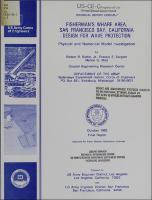Please use this identifier to cite or link to this item:
https://hdl.handle.net/11681/12576| Title: | Fisherman's Wharf area, San Francisco Bay, California, design for wave protection : physical and numerical model investigation |
| Authors: | United States. Army. Corps of Engineers. San Francisco District United States. Army. Corps of Engineers. Los Angeles District Bottin, Robert R. Sargent, Francis E. Mize, Marvin G. |
| Keywords: | Breakwaters Fisherman's Wharf, San Francisco Bay San Francisco, California Harbors Ports Hydraulic models Shore protection Hydrodynamics |
| Publisher: | Coastal Engineering Research Center (U.S.) Engineer Research and Development Center (U.S.) |
| Series/Report no.: | Technical report (U.S. Army Engineer Waterways Experiment Station) ; CERC-85-7. |
| Description: | Technical Report Abstract: A physical model and a numerical model were used to investigate the design of proposed breakwater configurations for wave protection in the Fisherman's Wharf area, San Francisco Bay, California. A 1:75- scale (undistorted) physical model was used to determine wave conditions 1n the harbor for locally generated short- period wind waves and swell conditions entering through the Golden Gate. The model included the entire Fisherman's Wharf area (Bordered by Pier 45 on the east and Municipal Pier on the west) and underwater contours in San Francisco Bay to a depth of 60 ft. A 40-ft-long wave generator, crushed coal sediment tracer material, and an automated data acquisition and control system were utilized in model operation. A hybrid finite element numerical model capable of calculating forced harbor oscillations for harbors of arbitrary shape and variable depth was used to calculate harbor resonance at Fisherman's Wharf. A numerical finite element grid was used to compute wave-height amplification factors and normalized maximum current velocities associated with the area's response to incident long-period waves ranging from 300 to 600 sec. A ship surge analysis was conducted for the ships moored along or near the Hyde Street Pier. Principal conclusions from the physical model investigation for the 90 plans tested were: (a.) Existing conditions are characterized by very rough and turbulent wave conditions in the various mooring areas of the harbor during periods of storm-wave attack. (b.) For existing conditions, sediment in the Aquatic Park area migrated in both the easterly and westerly directions depending on the angle of wave approach. This movement occurred for only the most severe locally generated storm wave conditions from the various test directions and swell conditions approaching from Golden Gate. (c.) The originally proposed improvement plan with the 1,450-ft-long solid outer breakwater with a 200-ft-wide entrance at Pier 45 (Plan 1) resulted in excessive wave heights in the harbor due to locally generated wave energy entering through the entrance. (d.) Of all the improvement plans tested (Plans 1-90), the 1,560-ft long outer solid breakwater configuration with the cumulative 400-ft segmented breakwater configuration at Pier 45 (Plan 78), was determined to be the optimum plan tested considering wave protection afforded the harbor and entrance, ease of navigation, and economics. The observed long-period wave data analysis and harbor oscillation evaluation for Plan 78 indicated that harbor oscillations did not develop at periods less than 171 sec and the resonant peak of the fundamental mode of oscillation (228-sec period) decreased 15 to 20 percent throughout the inner harbor area. Ship surge motion results indicated that the resonant response of ships in the historic fleet was at periods lower than the fundamental mode of oscillation. The combined results of the physical model study, harbor oscillation study, and ship response analysis for the historic fleet moored along the Hyde Street Pier provide a detailed analysis of short- and long-period wave activity and the resulting predicted ship response changes. In summary, Plan 78 was determined to be the optimum plan tested for short-period wave protection and did not result in significantly changed long-period harbor oscillation or ship mooring conditions. NOTE: This file is large. Allow your browser several minutes to download the file. |
| Rights: | Approved for public release; distribution is unlimited. |
| URI: | http://hdl.handle.net/11681/12576 |
| Appears in Collections: | Technical Report |
Files in This Item:
| File | Description | Size | Format | |
|---|---|---|---|---|
| TR-CERC-85-7.pdf | 45.19 MB | Adobe PDF |  View/Open |